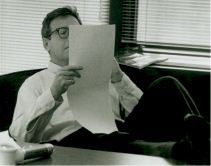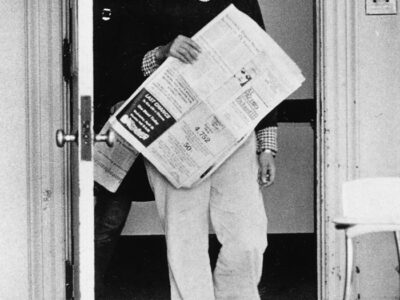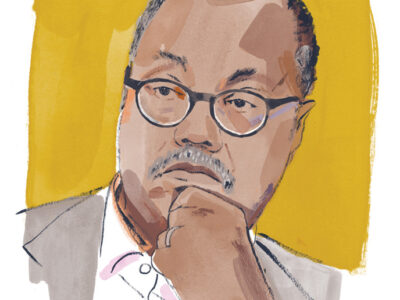
The late Alan Halpern was more than just a brilliant, groundbreaking editor.
By Samuel Hughes
He was an unlikely Godfather. Shy, gentle, witty, iconoclastic—Jewish—Alan Halpern C’47 appeared, on the surface, the anti-Don.
True, he carried a stiletto and wasn’t afraid to use it, but its blade was made of words—sharp, filigreed, wielded bluntly or with finesse, depending on the occasion. His edge could make you laugh or howl, sometimes at the same time—assuming you could understand what he was saying. Did I mention that he mumbled like Brando?

He built a big-city magazine racket out of nothing, at a time when no one had ever seen such a thing, because none existed. For nearly 30 years he oversaw (certainly never ruled) his ink-stained wise guys in the City of Brotherly Love. As the Numbers swelled and the praise and precious metals showered down, he became a legend. And when he forgot who made him, he was summarily unmade by the capo di tutti capi. Then, exiled, excommunicated, and defenestrated, he became a consigliere, imparting his mumbled wisdom into new rackets of words.
Though he described himself as “a hermit progressing to a recluse,” he was an oddly social hermit, and over the years he amassed a large and disorganized-crime family of writers and editors and wanna-be’s. They came to him for advice and affection and wisdom and stroking and jobs, not necessarily in that order. They never kissed his ring, but they gave him love and respect and gossip and parties, and that was plenty. When he made one of them an offer they couldn’t refuse, it was usually in the form of a chance—to edit or write for a terrific magazine or newspaper. In the end, their brains and their hearts and their signatures were inevitably on the page with his.
OK, so I’ve stretched things a little here. I feel fairly safe in saying that Alan—who died December 13 after several years of declining health—wouldn’t mind. After all, he made a career out of stretching things. What mattered was the story.
I only go back 20-some years with Alan, which makes me something of a Johnny-come-lately in the context of his Family. I never worked for him, but I worked with him on a couple of magazine proposals; more important, he steered me to the Gazette, gave me quiet support and encouragement, made me some offers I couldn’t refuse, and was an unusually agreeable lunch companion—even if I couldn’t always figure out what the hell he was saying.
To some, the notion of being the Godfather of Philadelphia journalism may seem like a modest achievement. It’s not. By radically re-imagining the city magazine, as Alan did with Philadelphia magazine for three decades, he not only created the template that would be copied across the country but helped transform journalism as well. Even the Gazette reflects his influence, and not just because he served for years on the alumni publications committee that has advised the magazine.
Back in 1970, the Gazette published a lengthy article about Philadelphia and the phenomenon of city magazines, focusing on Alan and some of his fellow Penn alumni, especially Gaeton Fonzi C’57, Charles MacNamara C’47, Nancy Love CW’49, and advertising director Frank DeLone W’42. Fonzi—who had just published a none-too-flattering, 15,000-word piece about Penn in Philadelphia titled “Up Against the Wall, Mother Ivy”—also helped the magazine win its first National Magazine Award (for specialized journalism) that year. Two years before that it had won a National Magazine Award special citation for its account of a corrupt Philadelphia Inquirer reporter who was subsequently jailed for selling his byline. It would win more National Magazine Awards and scores of other significant journalistic prizes.
“The best city magazines are covering a wide range of subjects in greater depth, and with more daring, than are the newspapers against which they compete for local attention,” noted the author of the Gazette piece, one Robert Ankerson. “And the best of the city magazines, by all accounts, is Philadelphia. The Columbia Journalism Review rates it ‘the outstanding magazine in this field,’ and ‘a model of what city magazines can become.’ Sigma Delta Chi, the national journalism fraternity, bestowed its coveted award for distinguished reporting on Philadelphia in two successive years, a feat matched by only one other magazine, Life.”
At that time, Alan and Herb Lipson, the magazine’s publisher, had nothing but nice things to say about each other. Alan “praises him for creating and protecting an environment of complete editorial freedom,” the article noted. “Alan also credits Herb with the most critical decision: to improve readership by pouring all available dollars into research and writing. This commitment to put out a decent product was the key, according to Alan: ‘It was a good business decision and it put us in the big leagues.’”
The quality of the writing was “consistently high, which suggests that Alan must exert strong editorial control,” the author speculated. But the magazine’s writers quickly disabused him of that notion. While Alan was indeed a gifted editor, much of his genius lay in attracting talented writers, letting them follow their noses, and editing in such a way that their voices came through loud and clear.
“Alan trusts everybody,” Fonzi told him. “That’s the key to the success of the operation. And that makes us really feel the pressure—we put it on ourselves.’”
That trust led to great things, though it also had a downside. As the magazine grew more powerful, it sometimes pushed the envelope in ways that were more snarky than funny.
“During Alan’s last five to 10 years at the magazine, that caustic humor did tremendous damage to the magazine,” noted one Philadelphia veteran who asked not to be identified. “They’d made fun of all of the people who deserved to be made fun of and moved on to those who were less deserving of derision. As a result, the magazine developed a reputation for being snide and nasty that it has never lost.”
Though I was a contributing editor at Philadelphia for a 10-year stretch that began shortly after Alan left in 1980, I read it only sporadically these days, and I doubt anyone would argue that it is a groundbreaking magazine anymore. And yet: once you get past the annoyingly contrived covers and relentless materialism, there is still—as there has always been—some very lively writing and reporting and buzz. That is the true legacy of Alan Halpern.
“Halpern invented the modern urban monthly magazine—stylish, sophisticated, and abrasively irreverent toward the local establishment—and consequently changed the face of American journalism,” wrote Dan Rottenberg C’64 in a eulogy for Broad Street Review, the online review of the Philadelphia arts scene that he edits. During Halpern’s 29 years as editor, Philadelphia“evolved from a Chamber of Commerce puff sheet with no editorial budget and just 6,000 readers to an innovator in investigative reporting and finally to a fat and trendy merchandising tool with 142,000 paid circulation by the time he left in 1980,” Rottenberg noted.
“His [story] was one that should have been told a hundred times, and in regions far beyond Broad Street,” wrote Lisa DePaulo C’82, now a correspondent for GQ, in an appreciation for Philadelphia, where she was a high-profile writer in the late 1980s and 1990s. “Alan invented city magazines, but never got the credit.”
Stephen Fried C’79, a long-time writer for Philadelphia, briefly its editor, and now an author and adjunct professor at Columbia University’s Graduate School of Journalism, never worked for Alan. But having been a beneficiary of what Alan built in Philadelphia, he wrote to the American Society of Magazine Editors (ASME) urging it to give Alan a posthumous Lifetime Achievement Award.
“I have always been amazed by what he contributed to the magazine industry, and to print journalism in general,” Fried wrote. “We all know the magazine business is New York-centric, even though magazine readers are all over the country and have distinctly regional and local needs. Part of the reason to honor Alan Halpern is to honor the idea of the importance of the regional-magazine business (and the increasing regionality of the national-magazine business). Regional magazines are, more than ever, an important part of the bricks and mortar of our industry. Alan Halpern was their primary architect.
“It can also be argued, I think, that the brand of journalism that came out of Alan Halpern’s Philadelphia—especially in the ’60s and early ’70s, before Watergate became synonymous with investigative reporting—made an important and unappreciated contribution to the so-called ‘new journalism’ that got all the national attention at Esquire and New York. Starting in 1961, Halpern was assigning and editing stories that not only featured vivid writing, but also vivid, in-depth reporting. The magazine’s best stories not only thrilled with verbal calisthenics: they were also gritty dramas that sent bad people to jail … ”
ASME ignored Fried’s suggestion. The New York Times didn’t even bother giving him an obituary. The snub still rankles.
“He was first, not New York and not [New York’s editor] Clay Felker,” points out Loren Feldman W’78, who wrote for Philadelphia in the 1980s and ’90s and edited it from 2000 to 2002. “That said, it’s a little tough to fully appreciate his contribution. In a weird way, it’s a little like reading Shakespeare today. The uninitiated might be tempted to ask, ‘Why does everyone think this guy’s a great writer—every other line is a cliché.’ And even a reader who understands that it was Shakespeare who created the cliché can’t possibly hear the lines the way they must have sounded when they were fresh. Same thing with Alan—though I really don’t mean to compare him with Shakespeare. He created a great format. Unfortunately, it’s been copied and perverted so many times and in so many places that it’s now hard to appreciate the genius.”
Eliot Kaplan C’78, editor of Philadelphia from 1991-1999 and now editorial talent director for Hearst Magazines, put it this way in a letter to Romenesko, the online journalism site: “In my opinion, Alan was simply the most underappreciated great editor of the past 50 years.”

For some people, Alan’s storyline ended in 1980. He got whacked, sort of—an intra-Family turf war, where the turf was respect and principle. In a sense, he whacked himself. When publisher Herb Lipson crossed the territorial line by hiring a writer without consulting him, Alan walked out. He had quit several times before. But this time the capo refused to ask him to return.
Alan was now a Don without a Family. The Family begged him to swallow his pride. But the capo would not yield, and neither would the Don. The result: excommunication with extreme bitterness, at least on Alan’s side. In the years that followed, a tradition began: When an editor of Philadelphia magazine got fired, he would get a phone call from Alan, and they would have lunch. Nobody should be editor of that magazine, he would say, unless they always had their bags packed.
Incidentally, of the six editors who succeeded Alan, three were Penn alumni: Kaplan, Fried, and Feldman. Fried made sure he had a book contract the entire time he was editor, so that he would know exactly what he would be doing when the inevitable axe fell.
Yet Alan’s story did not end there. He was never Don of a magazine again, but he became a great consigliere, a consultant who helped create a broad mix of magazines. One was Manhattan, Inc., whose publisher was … Herb Lipson.
“It was the hot magazine of the moment in the mid-to-late ’80s,” notes Feldman, “and Alan’s fingerprints were all over it. He came up with the idea and he convinced Herb to hire Jane Amsterdam, then a young editor at The Washington Post Style section.” Manhattan, Inc. won the National Magazine Award for General Excellence in 1985 and in Fried’s view, “forever changed all business writing.” (Under a different editor, it soon folded.)
Alan left his mark on other magazines—including Avenue and PhillySport and Atlantic City—and some of his best ideas never saw the light of day. He also served as a mentor for scores of young writers and editors, giving advice, dispensing patronage, and standing up for them, right or wrong.
What inspired so much loyalty among the ink-stained wretches who worked for and with him or came to him for counsel or encouragement or understanding was his strange mix of wit, blunt honesty, wisdom, generosity, and practical advice. “He was a collector, not of art, but of people,” said Philadelphiamainstay Carol Saline. “And he had a way of making each of us feel like we were the prize piece in his collection.”
Furthermore, “Alan was a one-man employment service, and he was always sending me and others notice of interesting job openings,” recalls Feldman.
Though he genuinely liked writers, and appreciated what they were trying to do, Alan didn’t pull punches when he didn’t like what they were writing or saying.
Lisa DePaulo, who started her career at Atlantic City in the early 1980s simply because Alan was consulting there, recalled an email he sent her not too long before he died.
“Dear Lisa,” it read. “I saw you on TV. What crap.”
“Like a great many others, I owe my career to the man,” she wrote. “Because he never let me forget how good I was. Or how bad I was. That was Alan’s gift.”
When he liked a story, he’d scribble a Terrific! in the margin. Two Terrifics meant he liked it a lot. DePaulo admitted that she “lived for three terrifics from Alan Halpern.”
Her first assignment from him, which turned into a cover story, was to walk up and down the beach talking to the lifeguards.
“Alan saw a story in everything,” she wrote. “And, for better or worse, he made me look at life the same way.
“Alan used to say (long before anyone else did), ‘Never let the facts get in the way of a good story.’ The journalism police didn’t like that very much. But Alan was correct. In his brilliant, iconoclastic way, nothing was more important than the telling of the story.”

Even as his heart and kidneys were giving out on him, Alan’s curiosity was as lively as ever. The boy who (as one old friend recalled) once blew out fuse boxes in his West Philadelphia neighborhood in order to cook a hotdog a laScientific American (hooking up wires to a primitive metal rotisserie) had become a man who would pull out a notebook at dinner and ask who knew what marmoreal meant (or half a dozen other words in the latest Umberto Eco tome). Alan regularly took classes at Penn, sometimes loving them, sometimes kvetching about the instructor. More than a few of the classes were film-related, since he was a long-time movie junkie who, with his wife, Bomie, would invite people over to watch movies in the basement theater of their Society Hill house.
A couple of months before he died, I had lunch with him at a Thai place near campus. That night I got an email.
“It was great having lunch with you at Singha,” he wrote. “On the way home I passed the Ritz East where A History of Violence was playing. I stopped in and watched the film—three stars. An altogether most satisfactory afternoon for this geezer.”
A few days later, Alan had another, more dramatic lunch with someone he had known for a much longer time: Herb Lipson.
Did you ever know that you’re my hero?
You’re everything I wish I could be.
I could fly higher than an eagle,
For you are the wind beneath my wings …
It was a weirdly hilarious performance—a middle-age bald guy lip-synching that schmaltzy Bette Midler number while making eyes at a big blown-up photo of Alan, who had been dead for just over a month. And yet somehow it seemed right.
The scene was a banquet room at the Society Hill Sheraton, and the crooner was a gifted writer and longtime fan of Alan’s named Bruce Buschel, who contributed some remarkable pieces to Philadelphia in the 1970s. He and another Alan protégé, Philadelphia Weekly editor Tim Whitaker, had organized the memorial service, and more than 200 people showed up, including the six editors who succeeded Alan at Philadelphia magazine.
They sat and listened and laughed and got lumps in their throats as, one by one, a couple of dozen of Alan’s old friends and protégés and colleagues—from old-timers like Fonzi and Rottenberg to relative newcomers like me—covered his virtual casket with verbal roses. For a crowd like that, the sheer quantity of the roses and the sweet fragrance they emitted were uncharacteristic—but genuine.
“Clearly,” says Loren Feldman, “there is no other person who could have brought that group of people together.”
Herb Lipson stood motionless at the podium. The restless, irreverent audience, sensing a moment of high drama, suddenly hushed. It was like a scene out of an updated Citizen Kane. The publisher once reviled in some quarters as the Man Who Whacked Alan was about to speak.
He confirmed the rumor: he and Alan had lunched together at the Palm, and had finally made up.
“At that lunch, Alan said, ‘So it’s taken 30 years to bury the hatchet,’” the impeccably dressed capo related. “I said, ‘There was no hatchet to bury.’
“I think he was the only editor I never fired,” he added. “And underneath it all, we loved each other.”
Many in the audience, including several he had fired, swear they saw tears in his eyes.
“The memorial service was one of the most psychologically challenging days of my professional life,” says Stephen Fried. “You could see all these generations of Phillymag people, whose lives were passing before their eyes and everyone else’s eyes. I felt honored to be part of it—to see Gaeton Fonzi up there, who I idolized—and at the same time saddened to see that the ugly breakup between Alan and Herb had been symbolically replayed so many times since, and that the professional family which had helped create so many great magazine people was so deeply and painfully dysfunctional.”
Fried compares the history of Philadelphia with that of Texas Monthly, which was started by Michael Levy W’68—who, after selling advertising for Philadelphia, decided to try the idea of a regional magazine in the Lone Star State [“Profiles,” March/April 2000].
“When I look at the history of Texas Monthly, I see what Phillymag could have been if it had more respect for its past and its accomplishments,” Fried notes. “Texas Monthly is a place where anyone who has made a contribution is forever considered part of the magazine. Phillymag is a place that has routinely ejected its best and brightest, so it has little institutional memory or appreciation of its legacy, except for Herb’s. And that’s sad, because I don’t know a publisher who is more keen on editorial excellence, more impressed by it and pleased to be part of it.
“Yet by constantly replaying the ouster of Alan, he assured exactly what has taken place: a huge diaspora of talented people who were bred to be a certain kind of journalist, good reporters and good writers and good colleagues, at Phillymag, but no longer have a relationship with the magazine. When you see how close Alan remained with his original, epic writers, and survey the wreckage of all the professional relationships since, it breaks your heart. So yes, when Herb got up on the podium and cried, it was Citizen Kane-ish indeed.”
Afterwards, the graying editors and writers and wise guys and cronies schmoozed and drank and laughed and mourned, remembering a distant time when nothing seemed so important as an amazing story from the latest issue of Philadelphia magazine.




